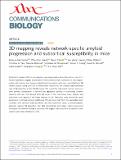Notice
This is not the latest version of this item. The latest version can be found at:https://dspace.mit.edu/handle/1721.1/134645.2
3D mapping reveals network-specific amyloid progression and subcortical susceptibility in mice
| dc.contributor.author | Gail Canter, Rebecca | |
| dc.contributor.author | Huang, Wen-Chin | |
| dc.contributor.author | Choi, Heejin | |
| dc.contributor.author | Wang, Jun | |
| dc.contributor.author | Ashley Watson, Lauren | |
| dc.contributor.author | Yao, Christine G | |
| dc.contributor.author | Abdurrob, Fatema | |
| dc.contributor.author | Bousleiman, Stephanie M | |
| dc.contributor.author | Young, Jennie Z | |
| dc.contributor.author | Bennett, David A | |
| dc.contributor.author | Delalle, Ivana | |
| dc.contributor.author | Chung, Kwanghun | |
| dc.contributor.author | Tsai, Li-Huei | |
| dc.date.accessioned | 2021-10-27T20:05:57Z | |
| dc.date.available | 2021-10-27T20:05:57Z | |
| dc.date.issued | 2019 | |
| dc.identifier.uri | https://hdl.handle.net/1721.1/134645 | |
| dc.description.abstract | © 2019, The Author(s). Alzheimer’s disease (AD) is a progressive, neurodegenerative dementia with no cure. Prominent hypotheses suggest accumulation of beta-amyloid (Aβ) contributes to neurodegeneration and memory loss, however identifying brain regions with early susceptibility to Aβ remains elusive. Using SWITCH to immunolabel intact brain, we created a spatiotemporal map of Aβ deposition in the 5XFAD mouse. We report that subcortical memory structures show primary susceptibility to Aβ and that aggregates develop in increasingly complex networks with age. The densest early Aβ occurs in the mammillary body, septum, and subiculum- core regions of the Papez memory circuit. Previously, early mammillary body dysfunction in AD had not been established. We also show that Aβ in the mammillary body correlates with neuronal hyper-excitability and that modulation using a pharmacogenetic approach reduces Aβ deposition. Our data demonstrate large-tissue volume processing techniques can enhance biological discovery and suggest that subcortical susceptibility may underlie early brain alterations in AD. | |
| dc.language.iso | en | |
| dc.publisher | Springer Science and Business Media LLC | |
| dc.relation.isversionof | 10.1038/S42003-019-0599-8 | |
| dc.rights | Creative Commons Attribution 4.0 International license | |
| dc.rights.uri | https://creativecommons.org/licenses/by/4.0/ | |
| dc.source | Nature | |
| dc.title | 3D mapping reveals network-specific amyloid progression and subcortical susceptibility in mice | |
| dc.type | Article | |
| dc.relation.journal | Communications Biology | |
| dc.eprint.version | Final published version | |
| dc.type.uri | http://purl.org/eprint/type/JournalArticle | |
| eprint.status | http://purl.org/eprint/status/PeerReviewed | |
| dc.date.updated | 2021-06-08T18:10:23Z | |
| dspace.orderedauthors | Gail Canter, R; Huang, W-C; Choi, H; Wang, J; Ashley Watson, L; Yao, CG; Abdurrob, F; Bousleiman, SM; Young, JZ; Bennett, DA; Delalle, I; Chung, K; Tsai, L-H | |
| dspace.date.submission | 2021-06-08T18:10:25Z | |
| mit.journal.volume | 2 | |
| mit.journal.issue | 1 | |
| mit.license | PUBLISHER_CC | |
| mit.metadata.status | Authority Work and Publication Information Needed |
